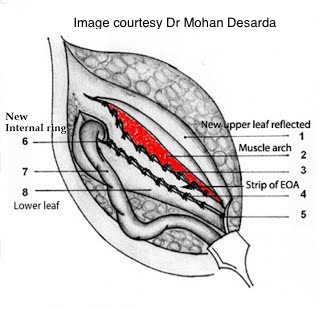A hernia can be simply called an abnormal bulge or an out-pouching in the body. Usually, they are the organs or tissues of the abdomen bulging out from their normal location through a weakness/defect in the muscle or tissues surrounding it. Hernias are quite common and can be of numerous kinds, the most common being inguinal (groin) hernias. Here, at Chennai Hernia Center, we specialize in treating many different kinds of hernias. Our chief consultant, Dr. Rengan has more than 30 years of experience in this field and is uniquely qualified to help address your concerns regarding hernias.
There are many different types of inguinal hernia repair surgery, broadly:
- Open surgery: Lichtenstein repair, Shouldice repair, Desarda technique etc
- Laparoscopic repair with/without mesh
In this sheet, we explain the Mesh-Free Desarda Technique.

What is Mesh-free Desarda Technique?
Mesh-free Desarda technique is a revolutionary type of hernia repair surgery which does not use any foreign material (eg. mesh) to provide reinforcement at the site of weakness.
How exactly is Mesh-free Desarda Repair different from regular hernia repair Surgery?
To understand this better, a brief overview of one of the most popular regular hernia repair techniques (called the Lichtenstein technique) is given below:
“In the Lichtenstein technique, an open incision is made at the site of hernia and repair is carried out by reinforcing the site of the weakness by covering it with a mesh rather than just sewing the edges of the weakness together.”
The laparoscopic approach to hernia surgery also follows the same technique, but uses instrument tubes through multiple small incisions to access and correct the hernia.
The main difference between Mesh-free Desarda repair and other types of inguinal hernia repair surgery from a purely technical standpoint is that this new form of repair does not involve a foreign body (mesh) being placed in the body. Instead, it utilises one of the body’s own tissues to achieve the goals of surgical reinforcement.
In the Desarda technique, the opening up of the weakness, the incisions, and the excision of hernia sac are all similar to that of the older open techniques. However, when it comes to reinforcing the weakness of the hernia wall, a unique approach takes place.
The surgeon cuts out a flap from a muscle close to the area called the external oblique aponeurosis. This flap is then manipulated and stitched in such a way that the defect is enveloped by it at the front and back. This is unique because now, because of the added reinforcement, the muscle will maintain tension adequately during physical activities like coughing or lifting objects. As the muscle flap also continues to remain attached to its main body, it is a healthy piece of living tissue that will not cause any side effects or untoward complications.
This is in contrast to mesh repairs which involve placing a foreign body – a mesh made of non-degradable material – at the site for reinforcement.
At Chennai Hernia Center, both Dr. Rengan and Dr. Vinayak are experienced hernia surgeons in many types of inguinal hernia repair surgery, including the Desarda Technique.
Are meshes bad?
No meshes are not bad. Mesh still remains the gold standard in hernia surgery. However we offer Desarda mesh-free technique to our patients who don’t want a mesh. Since the beginning of hernia surgery’s long history, one of the most common issues faced by surgeons was the high rate of recurrence in hernias. It was then, after a lot of trial and error, that the idea of placing a mesh over the repair site for reinforcement was introduced. The results were exceptional and soon, the use of non-mesh repairs was almost phased out.
There are certain complications associated with meshes in certain groups of patients. Only in them, we would electively advise a mesh=free hernia surgery. One of the examples is a strangulated hernia where meshes can get infected.
I have heard there are other Mesh-free techniques as well. Why are they not preferred?
As mentioned earlier, the first inguinal hernia repair surgeries were mesh-free techniques (simply because surgical meshes hadn’t even been invented!). Nevertheless, these techniques pioneered by Bassini and then furthered by Shouldice paved the way for hernia repair.
By the 1960s, with Lichtenstein’s introduction of hernia repair with a mesh, these techniques fell out of popularity and were reserved for use only in certain exceptional cases. It was after a few more decades, in 1983, that Dr. Mohan Desarda came up with a new and efficient mesh-free technique – one that can be considered on par with the current mesh or laparoscopic surgeries.
Therefore, a good question to ask any surgeon when being told of the need for surgery is the NAME of the surgery or the technique. IF a mesh-free technique is to be used, make sure to ask for the Desarda repair.
As you can see, hernia repair is an operation with various techniques for a common problem. There is still no definitive answer in the medical field as to which is the best hernia surgery. Even older techniques still have to be performed in certain scenarios. This is why a heart-to-heart conversation with your doctor is necessary before embarking on surgical treatment. At Chennai Hernia Center, our doctors will provide you detailed information on what surgery is being preferred, what technique can be used and WHY. Not only will your physical or medical condition be kept in mind before prescribing or deciding on the type of surgery, your personal opinion will also be sought.
We believe it is important that patients understand their body just as well as we do before undergoing any treatment, let alone something as invasive as surgery. We welcome you to contact or visit our center for any questions or queries you may have.
Many thanks to Dr. Mohan Desarda for his contributions to the field of hernia repair.
